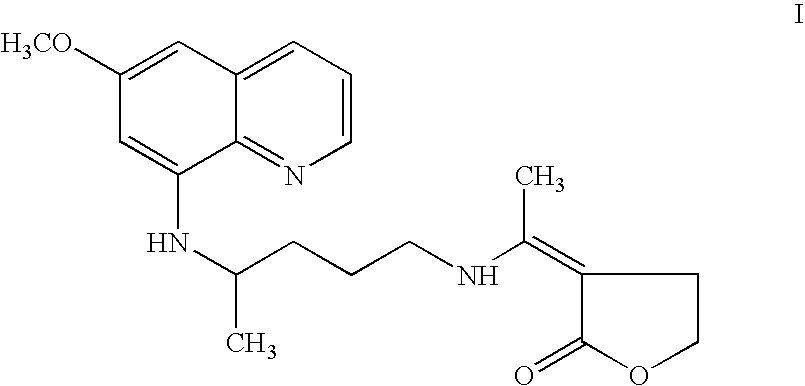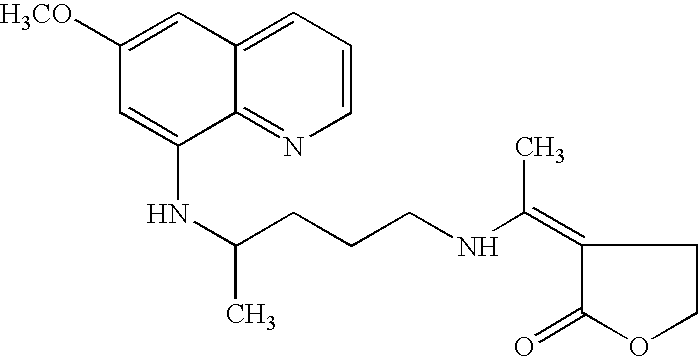Combination kit used in the treatment of malaria
- Summary
- Abstract
- Description
- Claims
- Application Information
AI Technical Summary
Problems solved by technology
Method used
Image
Examples
example 1
[0052]Combination kit consisting of chloroquine tablets and capsules of 3-[1-[[4-[(6-methoxy-8-quinolinyl)amino]pentyl]amino]ethylidene]-dihydro-2-(3H)furanone (I)[0053]A. Each tablet contains 500 mg of chloroquine phosphate equivalent to 300 mg chloroquine base. The tablet containing chloroquine may be prepared by conventional techniques.[0054]B. Each capsule contains 25 mg of 3-[1-[[4-[(6-methoxy-8-quinolinyl)amino]pentyl]amino]ethylidene]-dihydro-2(3H)furanone (I).
[0055]The capsule containing compound I may be prepared according to the following formulation by the procedure as described:
[0056]
Compound I25mgLactose250mgColloidal silicon dioxide2mgMagnesium stearate10mg
Procedure:
[0057]Compound I (25mg), lactose (250 mg), colloidal silicon dioxide (2 mg) are separately sifted through an S. S. screen no. 40 fitted on a vibratory sifter and transferred to a octagonal blender and the contents are mixed for 40-45 minutes. Then magnesium stearate (10 mg) is sifted through a S. S. screen ...
example 2
[0065]Combination regimen of chloroquine and 3-[1-[[4-[(6-methoxy-8-quinolinyl)amino]pentyl]amino]ethylidene]-dihydro-2(3H)furanone(I) tested against P. cynomolgi in rhesus monkeys.
[0066]The therapeutic effect of the combination regimen consisting of chloroquine and 3-[1-[[4-[(6-methoxy-8-quinolinyl)amino]pentyl]amino]-ethylidene]-4,5-dihydro-2(3H)furanone (I) was tested against P. cynomolgi in rhesus monkeys. 3-[1-[[4-[(6-methoxy-8-quinolinyl)-amino]pentyl]amino]ethylidene]-dihydro-2(3H)furanone(I) was administered in the dose level of 4.00 mg / kg (to 3 monkeys), 3.00 mg / kg (to 3 monkeys), 2.50 mg / kg (to 4 monkeys), 2.00 mg / kg (to 3 monkeys) and 1.25 mg / kg (to 9 monkeys) for 7 days. Chloroquine was administered as a companion drug at 5 mg / kg (base) dose. Minimum curative dose of compound I was found 1.25 mg / kg in 9 monkeys. Doses higher than 1.25 mg / kg i.e. 2.0 mg / kg (base), 3.00 mg / kg (base), 2.50 mg / kg (base), and 4.00 mg / kg (base) were also found to be curative in 3 monkeys, 3 mo...
example 3
Toxicity Study Data
[0067]3-[1-[[4-[(6-methoxy-8-quinolinyl)amino]pentyl]amino]ethylidene]-dihydro-2(3H)furanone (I) was evaluated vis-à-vis primaquine for toxicity related to methemoglobin formation in human.
[0068]The methemoglobin toxicity of compound I was evaluated via-à-vis that of primaquine in normal human volunteers. It was found that when the human subjects were administered with 25 mg daily dose of compound I for 7 days the methemoglobin level rose from 2.29% to 3.02% and in case of 15 mg daily dose of primaquine for 7 days the methemoglobin level rose from 3.97% to 16.23%.
[0069]It is thus evident from above data that the compound I is safer than primaquine.
PUM
| Property | Measurement | Unit |
|---|---|---|
| Time | aaaaa | aaaaa |
| Mass | aaaaa | aaaaa |
| Mass | aaaaa | aaaaa |
Abstract
Description
Claims
Application Information
 Login to View More
Login to View More - R&D
- Intellectual Property
- Life Sciences
- Materials
- Tech Scout
- Unparalleled Data Quality
- Higher Quality Content
- 60% Fewer Hallucinations
Browse by: Latest US Patents, China's latest patents, Technical Efficacy Thesaurus, Application Domain, Technology Topic, Popular Technical Reports.
© 2025 PatSnap. All rights reserved.Legal|Privacy policy|Modern Slavery Act Transparency Statement|Sitemap|About US| Contact US: help@patsnap.com


